La Maison is a woodcut created about 1922/1923 by Russian artist Marc Chagall. It is pencil signed and editioned 2/20. This impression was printed in 1950 on ivory wove paper. The reference is Kornfeld 32 and the dimensions are 11-1/16 x 7-15/16 inches.
While in Berlin in 1922, Chagall was introduced to the techniques of printmaking by Hermann Struck and he completed his first etchings in three weeks. He also produced six woodcuts during his time in Berlin and they also relate to life in Russia; they would be the last the artist produced as an Eastern Russian artist. In 1922, the policies of Vladimir Lenin had a firm grip on the citizens and this woodcut is haunting in its imagery. A uniformed man armed with a gun has his leg raised in a lockstep. His head is hidden by the overhang of the roof hiding him while he seemingly eavesdrops on conversations within the house. A boot and cap on the roof appear as symbols of the lost Russia of Chagall’s childhood. A further tribute to Russia are the initials PC CP carved into the sky at the peak of the roof.
Marc Chagall, painter, printmaker, sculptor, stage set designer, and stained glass artist, was born Moishe Shagal on 7 July 1887 in Vitebsk, Russia. From 1907 to 1910, he studied in Saint Petersburg, at the Imperial Society for the Protection of the Arts and later with Léon Bakst. In 1910, he moved to Paris, where he associated with Guillaume Apollinaire and Robert Delaunay and encountered Fauvism and Cubism. He participated in the Salon des Indépendants and the Salon d'Automne in 1912. His first solo show was held in 1914 at Der Sturm gallery in Berlin.
Chagall visited Russia in 1914 but was prevented from returning to Paris by the outbreak of war. He settled in Vitebsk, where he was appointed Commissar for Art in 1918. He founded the Vitebsk Popular Art School and directed it until disagreements with the Suprematists resulted in his resignation in 1920. Chagall moved to Moscow and executed his first stage designs for the State Jewish Chamber Theater there. After a sojourn in Berlin, he returned to Paris in 1923 where he met Ambroise Vollard. His first retrospective was held in 1924 at the Galerie Barbazanges-Hodebert, Paris. During the 1930s, he traveled to Palestine, the Netherlands, Spain, Poland, and Italy, and in 1933, the Kunsthalle Basel held a major retrospective of his work. During World War II, Chagall fled with his family to the United States. It was in New York, in 1943, that he met and worked with Stanley William Hayter at Hayter's renowned Atelier 17. He worked extensively on a suite of etchings based on a circus theme, utilizing string and textile imprints. Chagall continued with his printmaking studies in New York, broadening his portfolio to include color lithographs, and in 1946, a retrospective of his work was mounted by the Museum of Modern Art in New York.
Marc Chagall settled permanently in France in 1948 and continued exhibiting in Paris, Amsterdam, and London. During 1951, he visited Israel and executed his first sculptures. The following year, the artist traveled in Greece and Italy. During the 1960s, Chagall continued to travel widely, often in association with large-scale commissions he received. Among these were windows for the synagogue of the Hadassah-Hebrew University Medical Center, Jerusalem, installed in 1962; a ceiling for the Paris Opéra, installed in 1964; a window for the United Nations building, New York, installed in 1964; murals for the Metropolitan Opera House, New York, installed in 1967; and windows for the cathedral in Metz, France, installed in 1968. An exhibition of the artist's work from 1967 to 1977 was held at the Musée du Louvre, Paris, in 1977-78, and a major retrospective was held at the Philadelphia Museum of Art in 1985.
Marc Chagall died 28 March 1985,in Saint-Paul-de-Vence, France.



